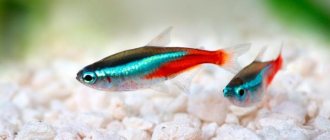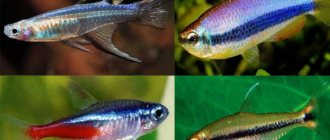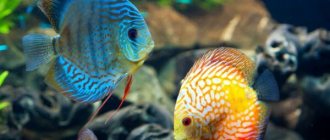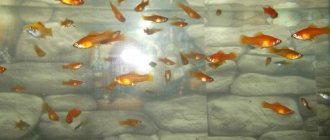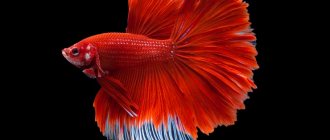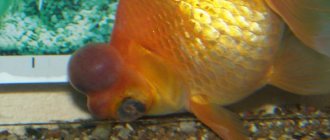Danio fish description and photo
If we talk about Danio in the context of decorative aquariums, then here the fish is favored by its richness of colors, peaceful disposition and ability to enliven the atmosphere in the aquarium. A bright flock of 7 or more individuals will fit perfectly into an aquarium with equally peaceful kids. Shimmering with multicolor, constantly playing in the upper layer of water, and in the case of GloFish, literally glowing with enthusiasm - Danio is an excellent choice for revitalizing and filling a beginner’s aquarium.
Table of basic parameters of maintenance, care and nutrition:
| What should be the volume of an aquarium for Danio? | from 30-50 liters for a school and from 120 liters for Malabar Danio |
| What should be the temperature in the aquarium for Danio? | from +20-26 °C |
| What pH should be in the aquarium? | from 6.5-7.5 pH |
| What should be the hardness of the water in the aquarium? | from 5-18° dH |
| What should be the substrate for an aquarium? | any |
| What kind of lighting should be in the aquarium? | 0.5-0.8 Watt/l daylight for at least 12 hours |
| What should be the movement of water in the aquarium? | moderate |
| Maximum fish size | up to 6 cm, Malabar Danio up to 12 cm |
| What does aquarium fish eat? | dry food, daphnia, tubifex, bloodworms |
| Type of aquarium fish | non-aggressive |
| Who is compatible with in an aquarium? | get along with small non-aggressive fish species; not compatible with shrimp |
| Lifespan of Danio | from 3-5 years, depending on the size of the individual |
Compatibility
Fish feel good together with loaches, female cockerels, guppies, mollies, swordtails, angelfish, corydoras catfish, gouramis, and platies.
You should not combine zebrafish and shrimp, barbs, and eels in one container. Compatibility with these aquarium inhabitants is possible, but not desirable.
If discus, koi carp, cichlids, goldfish and astronotus live in a pond, then it is better not to put zebrafish there.
The table will help you find good neighbors for your zebrafish.
Since zebrafish are schooling fish, there should be at least 5 individuals in one group. Otherwise, zebrafish become irritable, experience severe stress, and may become inactive and lethargic. If a school of zebrafish shows aggressiveness towards its neighbors, then the population should be increased.
Danio care and maintenance at home
Danios are not very demanding to care for, and are therefore recommended for beginners. It is enough to choose an aquarium that meets the optimal requirements for water and light. Periodically replace the water in it with settled water. And of course, don’t forget to feed, but don’t overfeed. Reproduction of Danios in captivity is simple and fast, which is why they are also loved in the scientific community as experimental specimens.
Reviews
Sometimes cases arise when the female carries eggs, but does not want to spawn. Then you need to help her shed eggs that are overripe. I place the pregnant individual in a ball of wet cotton wool and hold it motionless with my left hand. I carefully squeeze out the overripe caviar with my right hand. If everything happened normally, then she will be ready for reproduction after seven days. Albina, Moscow
Pink danios willingly spawn both in general and in a separate tank. I always take several males for 1 female. Leopard danios spawn approximately once every four weeks, and remain faithful to each other throughout the mating season, and golden danios can remain paired all their lives, but I haven’t tested it myself! I don’t have any gold ones yet, but I’m planning to buy them. Denis, Voronezh
What to feed Danio
Danios are unpretentious in food, but still it is worth making a bias towards floating food. Daphnia and bloodworms are very good options. When choosing between dry and live/frozen food, the latter will be preferable due to its positive effect on the color of pets (this essentially applies to most types of aquarium fish). However, today, among the dry food from popular manufacturers, flakes have already appeared, designed specifically to enhance the natural color. Good results are obtained: tetra pro color, tetra rubin, tetra fill, sera red parrot.
Life hack: simple dry food soaked in carrot juice also gives good color results).
You need to feed twice a day, in fractional portions, removing the remains of uneaten food.
Nutrition
As in keeping, in feeding, active representatives of the carp family showed themselves to be unpretentious pets. Phenotypes enjoy eating dry store-bought food, but it should be noted that to improve health, it is necessary to include live food in the zebrafish diet from time to time. If the fish eat only dry food, the owner may soon learn about such a terrible phenomenon as zebrafish disease.
Popular Danio Species
There are several species of Danio that are most popular among aquarists:
Danio rerio photo
The most common subspecies. Grows up to 7 cm. The color is silver, with blue stripes. It is from Danio rerio that the genetically modified variety GloFish was bred.
Danio malabar photo
The average size is 10 cm. Individuals 12-15 cm are often found. The color is silver, has a greenish line along the body, with lemon splashes. Unlike other representatives of Danio, it requires an aquarium with a volume of 120 liters or more.
Spot Zebrafish
Size from 4 to 5 cm. It has a white-golden color with an olive back and black stripes crossing the body. Below the stripes, the body is dotted with black dots, which influenced the name.
How to distinguish a female from a male
Males are smaller than females, and their bodies are more elongated. Females have a rounded belly. If the female has a swollen belly during the spawning period, she carries eggs. Males can be recognized by their bright colors. Some species have characteristic distinctive features:
- firefly or glofish: males have orange stripes, females have yellow stripes;
- spot zebrafish: males have a white abdomen, females have an orange one;
- Burmese: males have an orange stripe on the abdomen, females have a white stripe.
What kind of aquarium is needed for zebrafish?
The habitat, if we are not talking about the Malabar giant, is an elongated aquarium from 30 to 50 liters. For all other species of Danio, a small aquarium of 10 liters or more is suitable. Considering the general mobility of Danio, it is worth equipping such an aquarium with a lid to avoid jumping out.
Danio has no special requirements for soil fillings and this applies to all varieties. Stones, sand, and artificial types of soil are suitable. The only thing that should be done is to pre-sterilize the soil by calcination or boiling.
If the aquarium is planned to be planted with living plants, for example, various types of sagittaria, Vallisneria nana, Vindelova fern and many others. It is better to select the soil not for Danio, but for specific types of plants. The fact that bright, saturated colors look great in an aquarium with Danios also speaks in favor of living plants. The same GloFish with their florescent colors, briskly flying over the emerald forest, create the atmosphere of a completely different world, a wild and uninhabited planet from a science fiction film.
Plants that are perfect for:
- glossostigma;
- sitnyag;
- marsilia quatrefoil;
- saggitaria;
- Java moss.
Java moss, a favorite among aquatic designers, can also be placed along walls or driftwood - it will look very beautiful and will not interfere with Danio playing near the surface.
Water for an aquarium with Danios must meet the following characteristics:
- temperature from +20-26°C;
- hardness from 5-18° dH;
- acidity from 6.5-7.5 pH;
- Regular water renewal (up to 30% weekly) should help maintain these parameters optimal.
Living in flowing reservoirs, Danios are demanding on water quality, cleanliness and high oxygen saturation. You should select a filter and compressor that are suitable in terms of power. It is better to set the current level to moderate. It is also necessary to install bright lighting at a rate of 0.5-0.8 Watt/l.
For what reasons do they chase each other and how to solve this problem?
Danios have proven themselves to be one of the most peaceful fish, but owners often encounter the opposite phenomenon: individuals constantly chase or oppress each other.
This behavior may be quite normal, since Danios have a very playful and active disposition. The fish chase each other without any aggression - this is what their lifestyle looks like , although many inexperienced owners think that there is a conflict in the aquarium.
Conflicts can indeed occur, since Danio must be kept in schools, the size of which is at least 5 individuals. Some males still feel too confident in such conditions and begin to attack other fish.
Active behavior of males can also be caused by pregnancy of Danio, because. During this period they chase females, so you need to be careful and pay attention to the “position” of the females in the aquarium.
If aggressive behavior emanating from specific individuals is observed, then the size of the flock needs to be increased. The aggressor's attention is focused on all the fish, and eventually he stops bullying.
In rare cases
Among the fish there is an individual with pronounced causeless aggression. All that remains is to remove such a troublemaker from the aquarium.
Who do zebrafish get along with?
Being a peace-loving fish, Danio gets along well with most small and non-aggressive fish: Guppies, Neons, Platies, Mollies, Swordtails, Norman's Blueeyes, rainbow fish and others. However, you should not add him to larger fish, which Danio can easily become a victim of.
Separately, it is worth noting the undesirability of keeping Danio together with aquarium shrimp, the young of which are a delicacy for Danio.
Lifespan of an aquarium fish Danio
The lifespan of Danio is from 3 to 5 years, depending on the size of the individual. Larger individuals measuring 10 cm or more live longer.
Breeding
Reproduction in captivity is easy. During spawning, the female lays from 50 to 300 eggs.
Before starting the process, a simple preparatory step is carried out. Individuals of different sexes are housed in separate tanks and fed heavily with bloodworms. The female should become noticeably rounder.
It is recommended to use a regular three-liter jar as a spawning tank, since the bottom in the center needs to be convex. They cover it with moss and press it down with stones. The level of settled water (5-6 days) should not exceed 10 cm.
In the evening, a female and two males are transferred to the tank, and spawning begins in the morning. If the process does not start, wait another day. On the third day, if there is no spawning, carefully pick up the fish with a damp cotton swab and carefully squeeze out the eggs with your finger; this does not harm the pet; it will be worse if you ignore the recommendation.
Natural reproduction looks like this: males chase the female around the spawning ground, pushing out future offspring from the abdomen, which are immediately fertilized and settle to the bottom under the algae, so the parents cannot reach them. After waiting for the process to complete, the adults are seated.
The short incubation period ends on the third day, marked by the appearance of the fry. They immediately begin to be fed with ciliates. After 3 days, the fry are moved to a larger container and fed with cyclops.
Reproduction in a community aquarium
Danio reaches sexual maturity at 5 months. Spawning of these fish is not difficult. It also happens well in a general aquarium, without outside stimulation. Spawning begins with vigorous courtship. Brightly colored males begin to intensively pursue females. Then spawning begins. The effectiveness of this event depends directly on the number of plants in the aquarium - unprotected eggs are easily eaten by the inhabitants. The ripening of caviar lasts 3-4 days. Next, it is still better to transplant the fry without releasing them into the general aquarium until they grow up.
Interesting Facts
- Unpretentious in care and maintenance, zebrafish (the most typical representative of this genus) are widely used to study the development cycles of vertebrates. These creatures were first proposed as model organisms by George Streisinger
- A significant advantage of zebrafish is its rapid development cycle: the embryo turns into a larva within three days. Their embryos are large and transparent, their development occurs outside the mother’s body - and this greatly facilitates the work with biological material.
Types of diseases
With proper care, zebrafish rarely get sick. However, various infections can be introduced: by introducing fish that have not been quarantined, or by adding non-sterile soil.
Plistophora zebrafish
Loss of appetite. The presence of white spots on the body. Disheveled fins. Shiver. Removal of severely affected individuals. Disinfection of the aquarium. Adding methylene blue or erythrocycline to the feed.
Trichodinosis in fish
Grayish coating on the body. Reduced color brightness. Friction on hard surfaces. Increasing the water temperature (+30-+31 °C is suitable). Add salt to the water (1 tablespoon of salt per 10 liters of water) for a month.
Danio's bulging eyes
Swelling of the abdomen and eyes of the fish. The inside of the eyes fills with whitish fluid. Testing water for compliance with requirements. Increasing the number of water changes to a twice-daily frequency.
Habitat
The distribution area of zebrafish is southeast Asia: Indonesia, northern India, Burma, Bangladesh, Nepal. Fresh water bodies are suitable for them to live in: lakes, rivers, streams with weak currents. Schools of frisky fish stay off the coast, in the warm upper layers of water. They feed on plankton and algae and quickly hide from danger in coastal vegetation, skillfully camouflaging themselves. They are also found in standing water in rice fields. To spawn, zebrafish go in shoals to shallow water, to the warmest places.
Acquisition
You can purchase fish through online stores, but it is still better to buy in pet stores, where you will see with your own eyes the health of each pet.
Glofish are schooling fish, so most often they take 3 or 6 individuals at once. Their cost is high and can reach up to 3 thousand rubles per flock.
When choosing fish, pay attention to the intensity and uniformity of color . No spots or changes in the skin - this may indicate the development of the disease).
The plumage should not have mechanical damage, 2 whiskers in each corner of the mouth. The fish are active, curious and healthy.
Origin
In nature, luminous zebrafish live in Southeast Asia. The specimens were collected from small rocky streams in the Mogaung Chaung River basin, near the towns of Kamayin (Kar Min) and Namma in Myanmar (Burma). This species appears to have a limited habitat only in this tributary. Collected specimens are bred in nurseries for commercial purposes. Similar specimens, the leopard zebrafish and the northern glowing zebrafish, were collected in the same area. Myanmar can be called the center of diversity of this genus, more than ten of its species are found here and most of them are endemic to the country.
Fish prefer small fast streams with a bottom covered with gravel and stones of various sizes, as well as places with a silted bottom, without aquatic plants and clean water. Some fish were found in shallow streams, only 30 cm wide and 20 cm deep, emerging from the river basin and wandering through the surrounding meadow pastures. They feed on insects and their larvae, as well as other small food.
The water temperature in those areas is usually 24.8 °C, pH 7.6.
